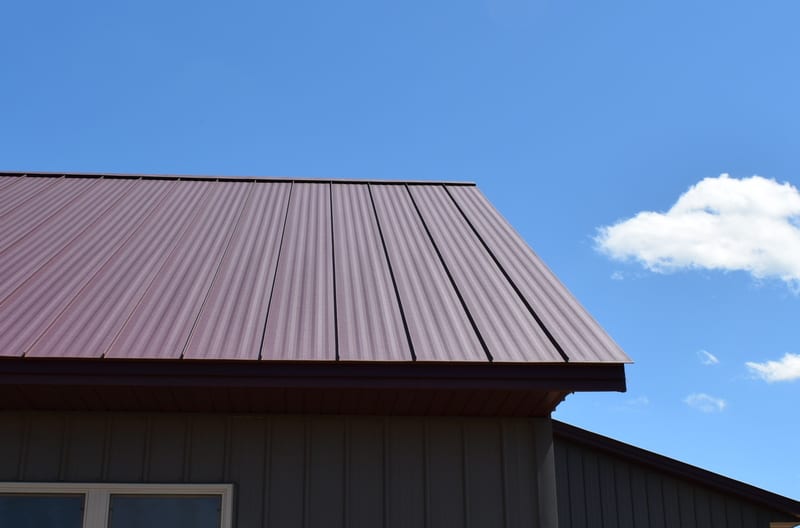Design Your Standing Seam Roof Now
When designing a standing seam roof system for your structure, there are several conversations and concepts up for discussion that need to be put into consideration. This includes, but is not limited to: oil canning, style of panel, length of panels needed, roof penetrations, snow guard and accessories.
When you start out the process, reach out to a manufacturer’s rep during the design phase to ensure metal is not only a good fit for the project, but that the type of panel you envision is suitable for your application. So many factors go into determining what materials will be used, including panel type, coatings, and substrate thickness. And of course, the fun part… like choosing color and style.
If you live in the city or town’s city limits, check with your local municipality to make sure there is not a restrictive covenant that defines the type of roofing materials that can be used in your subdivision. For example, some restrict the type of fencing materials that can be used, i.e. Vinyl vs wood.
Oil Canning
Oil canning….. What in the world is it? In summary, oil canning is a visible waviness in the flat areas of metal roofing – specifically a standing seam roof system – and metal wall panels. In technical terms, oil canning is referred to as elastic buckling (more commonly known as “stress wrinkling”). It can occur in any type of metal panels: steel, aluminum, zinc, or copper. Be sure to have this discussion early on, and make sure the building owner knows what to expect visually, before any decision making takes place.
Expansion & Contraction of a Standing Seam Roof System
Metal continually expands and contracts due to the climate conditions. It’s important to use the proper installation technique required, and materials that will accommodate it. Avoid panel laps in roof systems whenever possible. However, properly installed panel lap installations are still highly effective on a standing seam roof system.
If you’re considering a transition between two different metal roofing slopes, be sure to contact a metal roofing manufacturer for the best approach when designing your standing seam roof system.
Roof Penetrations
Evaluate all roof penetrations (i.e. roof vents, soil pipes, etc.) during the design phase. Use curbs if the penetration flashing doesn’t allow for easy water flow on all sides of the penetration. The designer should always specify penetration materials provided by the metal system manufacturer (and not substitute with other products if at all possible) and state that these materials should be applied in accordance with the manufacturers requirements for best possible results.
Take note that asphalt-based adhesives and cut backs are typically not compatible with metal systems, and should be avoided (even in emergency repair situations).
Standing seam roof systems are typically fastened at the eave, and in doing so, creates thermal movement that accumulates at the ridge. Openings that occur from this type of movement are eliminated with the design of metal ridge covers that are attached to the metal panels. The metal ridge covers should be designed to accommodate movement and flex as the panels expand and contract. The panel closures serve as weatherproofing protection, and when professionally installed, eliminate moisture intrusion on a standing seam roof system.
Gutters
Accessories, like gutters, serve an important purpose. Gutter width should be determined by a calculation that considers the average rainfall rate in the geographic area, plus the size and slope of the roof area. Larger gutter widths will accommodate more flow and are less likely to back up during heavy precipitation events. An undersized gutter will result in oversaturation of water at the foundation (as water flows directly over the gutter to the ground because the gutter is full) or worse, the potential of water backing up under the roofing panels at the eaves.
Snow Guards
For projects in areas that receive snow, make sure you have discussed Snow Guard rails. The purpose of these is to hold the snow back and eliminate the chances of an avalanche of snow falling off the roof, causing potential injury.
Also, be sure to discuss potential corrosion that could take place between panels made of different materials or from different manufacturers. Other topics to ask your installer or manufacturer include flashing at Roof Curbs, gables, rakes, and end wall transitions.
There is no way to have a standing seam roof system look like brand new 50 years after its initial installation, but it is possible to still look great if the correct materials are used and installed correctly. Considering standing seam metal roofing offers a life expectancy of 50-60 years, a standing seam metal roof is nearly maintenance free, and 100% recyclable (not only made from recycled products, but are recyclable after use) are factors that will outweigh any of the negatives.
If you’re interested in learning more about standing seam roof systems, check out our website at AllAmericanSteel.net, or contact us anytime through our contact page. Also feel free to visit our in-store display at All American Do it Center stores in Tomah, Sparta and Richland Center Wisconsin.



